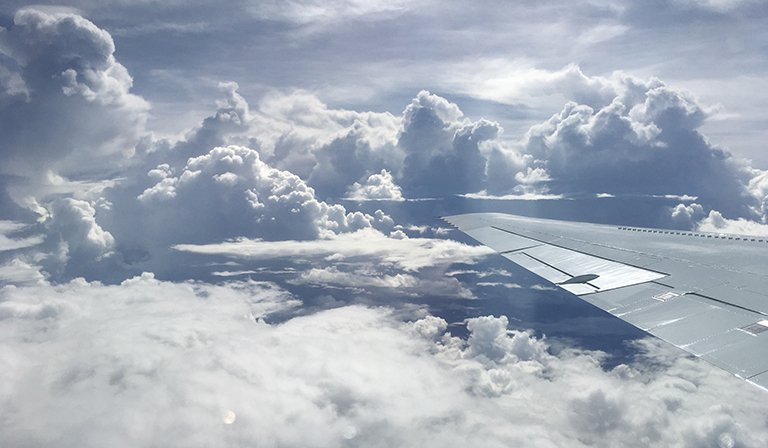Ask NASA Climate | March 16, 2017, 12:10 PDT
Journey through the atmosphere

Clouds above the Pacific Ocean on the ATom leg from Nadi, Fiji, to Christchurch, New Zealand, on February 6. Credit: Roisin Commane.
The world seems smaller to Steve Wofsy than it used to. He’s the lead scientist for NASA’s Atmospheric Tomography (ATom) mission, an airborne mission to survey the gases on the world’s atmosphere that has just finished up a round-the-world flight.
Wofsy is tall and lanky and at 70 is still an active professor and researcher at Harvard University. He began thinking about a mission like ATom 30 years ago to take a slice of the atmosphere from pole to pole to see what gases were there both naturally and from pollution, how they behaved, and how they collectively affected Earth’s climate. Building on years of research and airborne field work, including a mission Wofsy led to sample the air above the Pacific from pole to pole, ATom brings more than 22 instruments and a hundred scientists from universities and agencies around the world to begin to close the loop on some outstanding questions.
Of particular interest are three greenhouse agents: ozone that occurs in the lower atmosphere as a result of human pollution, methane that also primarily comes from human activities, and black carbon, tiny black particles that come from fires that absorb heat and interact with clouds. These three make up the number two, three, and four most important human-emitted greenhouse agents after carbon dioxide, which is also being measured.
"Together they account for almost as much warming of the surface as carbon dioxide," Wofsy explained to me.
What sets them apart is how long they stay in the atmosphere. Unlike carbon dioxide which persists for over a century before being removed from the atmosphere, ozone in the lower atmosphere reacts with other gases within a year and methane sticks around for more than a decade. This means that reducing human emissions of these two gases could make a difference in the greenhouse effect in our lifetimes. But because they're both reactive, their concentration in the atmosphere can vary a lot from place to place. Hence the importance of the up-close, around-the-world measurements made by the instruments on the ATom mission to get a handle on how much is there now and how it may change in the future.
The sky was overcast when we went out to see the plane. NASA’s DC-8 looks like an older-model commercial aircraft from the outside (which it was), but from the inside its all science. Instead of rows of seats, large metal frame structures – racks to hold the instruments and computers – dominate the view with only a pair of seats next to each one. A few scientists were onboard fine-tuning their instruments or resupplying gases and filters.
Instead of hunting for particular gases in particular pollution-prone regions, Wofsy and the science team want to measure everything they can, not just the greenhouse gases — from soot and remnant gases of fires burned on land, sulfur dioxide from volcanoes and coal-burning power plants, and industrial air pollutants. They are flying near some major land masses, but more importantly, they’re flying high over the ocean, the remotest and supposedly cleanest parts of the atmosphere to see how far humanity’s fingerprints on the air have traveled.
The answer: pretty far. This February, above the Arctic, they saw traces of Asian pollution. Above both the Pacific and Atlantic, they saw traces of African fires.
ATom left New Zealand for the southern tip of Chile and then completed the circuit flying north over the middle of the Atlantic Ocean. They arrived back in California at the end of February, finishing their second of four deployments, one to take place in each season. The mission takes to the air next this October.
